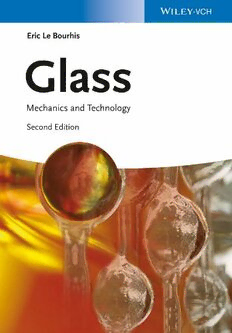
Glass: Mechanics and Technology PDF
Preview Glass: Mechanics and Technology
G L Eric Le Bourhis lass is a material with essentially unlimited application possibilities. This second e edition of a comprehensive reference in glass science, points out the correlation between B the performance of industrial processes and practice-relevant properties, such as o strength and optical properties. Interdisciplinary in his approach, the author discusses u both the science and technology, starting with an outline of history and applications, r Glass h glass structure, and rheology. i s The sections on properties include mechanical strength and contact resistance, ageing, mechanics of glass processes, the production and control of residual stresses, high-tech products, and current research and development. Applications include glazing, packaging, optical glass, glass fibers for reinforcement, and abrasive tools. The development of touchscreen technology showed how important were the design and resistance of thin flexible glass and these new thin aluminosilicate glasses are also discussed. Mechanics and Technology Containing a Foreword by René Gy, Saint Gobain. Second Edition Eric Le Bourhis is professor at Poitiers University (Futuroscope, France). He initially taught at a secondary school in Lima (Peru) between 1989 and 1991. Upon returning to France, he gained his PhD at Paris VII University in 1994. During this period, he started investigations of the thermo-mechanical properties of semiconductors. Then he joined Evry University for one year as an assistant professor and subsequently the Saint Gobain R&D team at Aubervilliers for 4 years as an engineer. During this industrial period, he applied contact mechanics to glass surfaces and coatings developed for glazing, and was also involved G in industrial production tasks. He joined Poitiers University in 1998, l a where he has pursued an activity to promote sol-gel hybrid coatings in s close collaboration with glass industrial manufacturers, while his other s activities focus on small-scale mechanics. • 2 n d E d i t i o n www.wiley-vch.de EricLeBourhis Glass Related Titles Janssens,K.K. Rouxel,T.(ed.) Modern Methods for Mechanical Properties Analysing Archaeological of Glass and Historical Glass 2015 2013 ISBN:978-1-848-21490-3(Alsoavailableina varietyofelectronicformats) PrintISBN:978-0-470-51614-0(Alsoavailable inavarietyofelectronicformats) Schmelzer,J.W.,Gutzow,I.S.,Mazurin, Jones,J.J.(ed.) O.V.,Todorova,S.V.,Petroff,B.B., Priven,A.I. Bio-Glasses Glasses and the Glass AnIntroduction Transition 2012 2011 PrintISBN:978-0-470-71161-3(Alsoavailable PrintISBN:978-3-527-40968-6(Alsoavailable inavarietyofelectronicformats) inavarietyofelectronicformats) Eric Le Bourhis Glass Mechanics and Technology Second Edition TheAuthor AllbookspublishedbyWiley-VCHarecarefully produced.Nevertheless,authors,editors,and Prof.EricLeBourhis publisherdonotwarranttheinformation UniversitédePoitiers containedinthesebooks,includingthisbook, InstitutP’ tobefreeoferrors.Readersareadvisedtokeep Bd.MarieetPierreCurie, inmindthatstatements,data,illustrations, 86962Futuroscope-Chasseneuil proceduraldetailsorotheritemsmay France inadvertentlybeinaccurate. LibraryofCongressCardNo.:appliedfor BritishLibraryCataloguing-in-PublicationData Acataloguerecordforthisbookisavailable fromtheBritishLibrary. Bibliographicinformationpublishedbythe DeutscheNationalbibliothek TheDeutscheNationalbibliothekliststhis publicationintheDeutscheNationalbibliografie; detailedbibliographicdataareavailableonthe Internet at <http://dnb .d-nb.de > . 2014Wiley-VCHVerlagGmbH&Co.KGaA, Boschstr.12,69469Weinheim,Germany Allrightsreserved(includingthoseoftranslation intootherlanguages).Nopartofthisbookmay bereproducedinanyform–byphotoprinting, microfilm,oranyothermeans–nortransmitted ortranslatedintoamachinelanguagewithout writtenpermissionfromthepublishers.Regis- terednames,trademarks,etc.usedinthisbook, evenwhennotspecificallymarkedassuch,are nottobeconsideredunprotectedbylaw. PrintISBN:978-3-527-33705-7 ePDFISBN:978-3-527-67942-3 ePubISBN:978-3-527-67944-7 MobiISBN:978-3-527-67945-4 oBookISBN:978-3-527-67946-1 CoverDesignFormgeber,Mannheim,Germany TypesettingThomsonDigital,Noida,India PrintingandBindingMarkonoPrintMediaPteLtd., Singapore Printedonacid-freepaper V Contents Foreword XIII PrefacetotheSecondEdition XV PrefacetotheFirstEdition XVII SymbolsandDefinitions(UnitsinParentheses) XIX PhysicalConstants XXV ListofAbbreviations XXVII 1 Introduction 1 2 Glass,ACeramicMaterial 5 2.1 FourClassesofMaterials 5 2.2 MaterialsProperties 11 2.3 SelectingMaterials 14 2.4 PerformanceIndices 16 2.5 ShapeFactorsinMechanicalDesign 19 3 GlassPrehistoryandHistory 25 3.1 NaturalGlasses 25 3.2 EarlyGlasses 29 3.3 FirstOpticalGlasses 33 3.4 ModernGlasses 34 3.4.1 Soda–Lime–SilicaGlasses 34 3.4.2 BorosilicateandAluminosilicateGlasses 40 4 ApplicationsofGlass 41 4.1 Glazing 41 4.2 Containers 47 4.3 OpticalGlass 49 4.4 GlassFibresforInsulationandReinforcement 50 4.5 AbrasiveTools 52 4.6 GlassManufacturers 54 VI Contents 5 GlassStructure 55 5.1 Introduction 55 5.2 SilicaGlassandRelatedGlasses 56 5.2.1 GlassNetwork 56 5.2.2 GlassNetworkModification 59 5.2.3 Short-RangeOrder 62 5.3 BorateGlassandRelatedGlasses 65 5.4 OrganicandChalcogenideGlasses 66 5.5 MetallicGlasses 67 5.6 AvoidingCrystallization 68 5.6.1 NucleationandGrowthofCrystallizedPhases 68 5.6.2 NucleationofCrystallizedPhases 69 5.6.2.1 HomogeneousNucleation 70 5.6.2.2 HeterogeneousNucleation 72 5.6.3 CrystalGrowth 74 5.6.4 Temperature–Time–Transformation(TTT)Diagram 76 5.6.5 Devitrification 77 5.6.6 FactorsThatFavourGlassFormation 78 5.7 VitroceramicFabrication 78 5.7.1 Introduction 78 5.7.2 ConventionalMethod(TwoStages) 79 5.7.3 ModifiedConventionalMethod(SingleStage) 80 5.7.4 Laser-InducedMethod 80 5.8 GlassSurface 80 5.8.1 SurfaceReaction 81 5.8.2 MolecularDiffusion 81 5.8.3 GlassNetworkInteractionwithWater 82 5.8.3.1 WaterReaction 82 5.8.3.2 IonExchange 82 5.8.3.3 GlassCorrosion 83 5.8.4 SurfaceProperties 84 6 GlassRheology 85 6.1 Viscosity 85 6.1.1 ViscosityandProcess 85 6.1.2 ViscosityMeasurement 88 6.1.2.1 RotationViscometer 89 6.1.2.2 FallingSphereViscometer 90 6.1.2.3 FibreElongationViscometer 91 6.1.3 ViscosityVariationwithTemperature 92 6.1.3.1 Introduction 92 6.1.3.2 Fragility 95 6.1.3.3 VFTEmpiricalFormula 96 6.1.3.4 MicroscopicApproach 97 6.2 GlassTransitionandItsObservation 101 Contents VII 6.2.1 ‘Observing’theGlassTransition 101 6.2.2 Dilatometry 103 6.2.3 DifferentialScanningCalorimetry 105 6.3 ViscousResponseofGlass 107 6.4 ViscoelasticResponseofGlass 109 6.4.1 Introduction 109 6.4.2 MaxwellandKelvinSolids 109 6.4.3 DynamicMechanicalAnalysis 111 6.4.4 ModellingRealSolids 115 6.4.5 FunctionalFormulation 116 6.4.5.1 Creep 116 6.4.5.2 StressRelaxation 117 6.4.5.3 Elastic–ViscoelasticCorrespondence 118 6.4.5.4 SuperpositionPrinciple(SimpleThermorheological Behaviour) 119 6.5 ThermalTemperingofGlass 121 6.5.1 Introduction 121 6.5.2 FreezingTheory 123 6.5.3 StressRelaxation 125 6.5.4 StructuralRelaxation 126 6.6 TransientStresses 131 6.7 ChemicalTemperingofGlass 133 6.7.1 Introduction 133 6.7.2 IonExchangeandStressBuild-Up 134 6.7.3 StressRelaxation 135 6.7.4 EngineeredStressProfileGlasses 135 7 MechanicalStrengthofGlass 139 7.1 TheoreticalStrength 139 7.2 TensileResistanceofGlass 140 7.3 StressConcentrationandGriffithEnergyBalance 147 7.3.1 StressConcentration 147 7.3.2 EnergyBalance 148 7.4 LinearElasticityCrackTipStressField 149 7.5 SIFunderNon-uniformStress 151 7.6 ToughnessMeasurement 151 7.6.1 CompactTension 152 7.6.2 NotchBeamTest 152 7.6.3 DoubleTorsion 153 7.7 InfluenceofResidualStressonStrengthand Fragmentation 153 7.7.1 InfluenceofResidualThermalStressonStrength 154 7.7.2 InfluenceofResidualChemicalStressonStrength 154 7.7.3 InfluenceofResidualStressonFragmentation 156 7.7.4 Impact-InducedFracture 157 VIII Contents 7.8 StatisticalWeibullAnalysis 158 7.8.1 Introduction 158 7.8.2 FunctionalFormulation 158 7.8.2.1 UniformTensileStress 160 7.8.2.2 Non-uniformTensileStress 160 7.8.3 PopulationofFlaws 161 8 ContactResistanceofGlass 165 8.1 SharpandBluntContact 165 8.1.1 Introduction 165 8.1.2 SphericalIndentation 166 8.1.2.1 ElasticLoading 166 8.1.2.2 HertzFractureandIndentationToughness 168 8.1.3 SharpIndentation 172 8.1.3.1 ElasticLoading 172 8.1.3.2 Elastic–PlasticLoading 173 8.1.3.3 Hardness 174 8.1.3.4 Radial–MedianCracking 179 8.1.3.5 IndentationToughness 182 8.1.3.6 LateralCrackingandChipping 184 8.1.3.7 BrittlenessIndex 184 8.2 SharpContactResistance 185 8.3 ScratchResistance 189 8.4 AbrasionResistance 191 8.5 IntroducingaControlledandCriticalSurfaceFlaw 193 8.6 CuttingandDrillingofGlass 194 9 AgeingofGlass 199 9.1 FatigueinGlass 199 9.1.1 StaticFatigue 199 9.1.2 TestingMethods 199 9.2 StressCorrosion 200 9.2.1 Introduction(DomainIII) 200 9.2.2 DomainsOandI:ReactionControlled 201 9.2.3 DomainII:TransportControlled 203 9.3 CharlesandHilligTheory 203 9.4 LifetimeunderStaticFatigue 205 9.5 Applications 207 9.6 NiSPhaseTransformation 208 9.7 CrackHealing 210 10 MechanicsofGlassProcesses 211 10.1 Introduction 211 10.1.1 Batching 212 10.1.2 Melting 213
